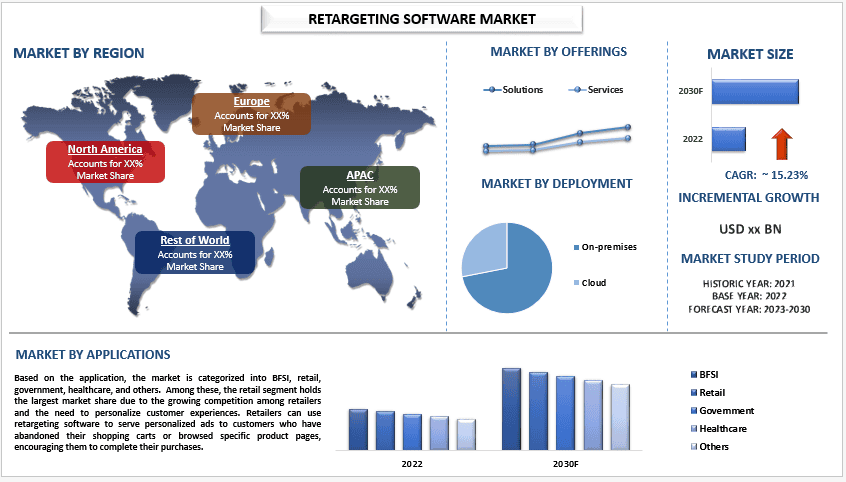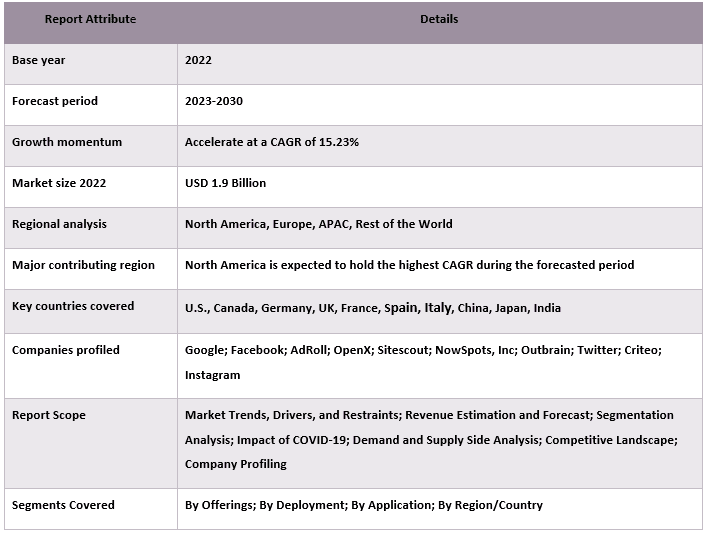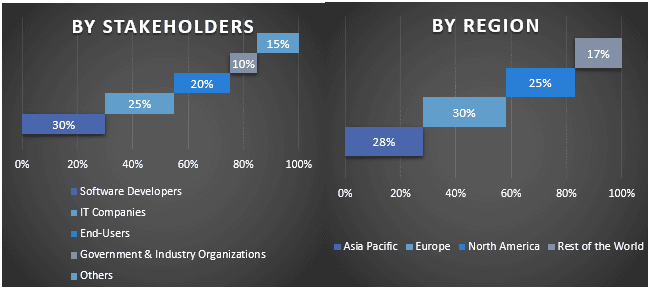- Home
- About Us
- Industry
- Services
- Reading
- Contact Us
Retargeting Software Market: Current Analysis and Forecast (2023-2030)
Emphasis on Offering (Solutions and Services); Deployment (On-Premises, Cloud-Based, and Hybrid); Application (BFSI, Retail, Government, Healthcare, and Others) and Region/Country.

Retargeting software market – Current Scenario and Forecast (2023-2030)
The retargeting software market was valued at 1.9 billion in 2022 and is expected to grow at a steady rate of around 15.23% in the forecasted period (2023-2030) owing to the increased competition as with more businesses shifting their focus to digital marketing, the competition for customer attention has increased significantly, therefore, adding values to the market. Moreover, the use of advanced technologies like AI and machine learning algorithms enables more accurate targeting and better ad placement, further increasing the demand for retargeting software. These advancements allow businesses to create more sophisticated and effective campaigns, increasing brand awareness and revenue growth. For instance, 91.6% of Fortune 1000 companies have plans to invest more in big data and AI initiatives.
Some major players operating in the market include Google; Facebook; AdRoll; OpenX; Sitescout; NowSpots, Inc; Outbrain; Twitter; Criteo; Instagram.
Insights Presented in the Report
“Among offerings, the solutions segment holds largest share of the market during forecast period.”
Based on the offering, the market is bifurcated into solutions and services. Among these, the solution segment holds the largest market share due to its widespread adoption by small and medium-sized enterprises. Solution providers offer pre-built templates, automation tools, and easy integration with various platforms, making it easier for businesses to implement retargeting software without requiring extensive technical expertise.
“Amongst deployment, clouds segment is holding the significant during the forecast period.”
Based on the deployment, the market is categorized into on-premises, clouds, and hybrid. Among these, the cloud segment holds the significant market share due to its ease of use, scalability, and cost-effectiveness. Cloud-based solutions provide businesses with flexibility in terms of pricing, allowing them to pay only for what they use, rather than investing in expensive hardware and infrastructure. Additionally, cloud-based solutions are often automatically updated, ensuring that businesses have access to the latest features and functionalities without requiring manual updates. For instance, according to O’Reilly’s latest Cloud Adoption report 47% of organizations are pursuing a cloud-first strategy, 30% are already cloud-native and 37% intend to be cloud-native in the coming years.
“North America to hold a significant share in the market in 2022.”
The North American region has witnessed a significant surge in the demand for retargeting software, marking substantial growth in this dynamic market. Businesses across various industries increasingly recognize the value of retargeting strategies to enhance customer engagement and boost conversion rates. As e-commerce continues to thrive, companies in North America are investing in sophisticated retargeting software to re-engage website visitors and target potential customers with personalized content. This surge in demand can be attributed to the ever-evolving digital landscape, where staying top-of-mind with consumers is crucial. According to recent studies, businesses can improve their return on investment (ROI) by up to five times if they use retargeting adverts effectively. Moreover, the robust growth of the retargeting software market in North America reflects a strategic shift towards data-driven marketing solutions, underlining the region’s commitment to leveraging technology for effective and targeted advertising campaigns.
Retargeting Software Market Report Coverage

Reasons to buy this report:
- The study includes market sizing and forecasting analysis validated by authenticated key industry experts.
- The report presents a quick review of overall industry performance at one glance.
- The report covers an in-depth analysis of prominent industry peers with a primary focus on key business financials, product portfolio, expansion strategies, and recent developments.
- Detailed examination of drivers, restraints, key trends, and opportunities prevailing in the industry.
- The study comprehensively covers the market across different segments.
- Deep dive regional level analysis of the industry.
Customization Options:
The global retargeting software market can further be customized as per the requirement or any other market segment. Besides this, UMI understands that you may have your own business needs, hence feel free to contact us to get a report that completely suits your requirements.
Table of Content
Research Methodology for the Retargeting Software Market Analysis (2023-2030)
Analyzing the historical market, estimating the current market, and forecasting the future market of the global retargeting software market were the three major steps undertaken to create and analyze the adoption of retargeting software market in major regions globally. Exhaustive secondary research was conducted to collect the historical market numbers and estimate the current market size. Secondly, to validate these insights, numerous findings and assumptions were taken into consideration. Moreover, exhaustive primary interviews were also conducted, with industry experts across the value chain of the global retargeting software market. Post assumption and validation of market numbers through primary interviews, we employed a top-down/bottom-up approach to forecasting the complete market size. Thereafter, market breakdown and data triangulation methods were adopted to estimate and analyze the market size of segments and sub-segments of the industry pertains to. Detailed methodology is explained below:
Analysis of Historical Market Size
Step 1: In-Depth Study of Secondary Sources:
Detail secondary study was conducted to obtain the historical market size of the retargeting software market through company internal sources such as annual reports & financial statements, performance presentations, press releases, etc., and external sources including journals, news & articles, government publications, competitor publications, sector reports, third-party database, and other credible publications.
Step 2: Market Segmentation:
After obtaining the historical market size of the retargeting software market, we conducted a detailed secondary analysis to gather historical market insights and share for different segments & sub-segments for major regions. Major segments are included in the report as offering, deployment, and application. Further country-level analyses were conducted to evaluate the overall adoption of testing models in that region.
Step 3: Factor Analysis:
After acquiring the historical market size of different segments and sub-segments, we conducted a detailed factor analysis to estimate the current market size of the retargeting software market. Further, we conducted factor analysis using dependent and independent variables such as various offering, deployment, and application retargeting software market. A thorough analysis was conducted of demand and supply-side scenarios considering top partnerships, mergers and acquisitions, business expansion, and product launches in the retargeting software market sector across the globe.
Current Market Size Estimate & Forecast
Current Market Sizing: Based on actionable insights from the above 3 steps, we arrived at the current market size, key players in the global retargeting software market, and market shares of the segments. All the required percentage shares split, and market breakdowns were determined using the above-mentioned secondary approach and were verified through primary interviews.
Estimation & Forecasting: For market estimation and forecast, weights were assigned to different factors including drivers & trends, restraints, and opportunities available for the stakeholders. After analyzing these factors, relevant forecasting techniques i.e., the top-down/bottom-up approach were applied to arrive at the market forecast for 2030 for different segments and sub-segments across the major markets globally. The research methodology adopted to estimate the market size encompasses:
- The industry’s market size, in terms of revenue (USD) and the adoption rate of the retargeting software market across the major markets domestically
- All percentage shares, splits, and breakdowns of market segments and sub-segments
- Key players in the global retargeting software market in terms of products offered. Also, the growth strategies adopted by these players to compete in the fast-growing market.
Market Size and Share Validation
Primary Research: In-depth interviews were conducted with the Key Opinion Leaders (KOLs) including Top Level Executives (CXO/VPs, Sales Head, Marketing Head, Operational Head, Regional Head, Country Head, etc.) across major regions. Primary research findings were then summarized, and statistical analysis was performed to prove the stated hypothesis. Inputs from primary research were consolidated with secondary findings, hence turning information into actionable insights.
Split of Primary Participants in Different Regions

Market Engineering
The data triangulation technique was employed to complete the overall market estimation and to arrive at precise statistical numbers for each segment and sub-segment of the global retargeting software market. Data was split into several segments & sub-segments after studying various parameters and trends in offering, deployment, and application in the global retargeting software market.
The main objective of the Global retargeting software market Study
The current & future market trends of the global retargeting software market were pinpointed in the study. Investors can gain strategic insights to base their discretion for investments on the qualitative and quantitative analysis performed in the study. Current and future market trends determined the overall attractiveness of the market at a regional level, providing a platform for the industrial participant to exploit the untapped market to benefit from a first-mover advantage. Other quantitative goals of the studies include:
- Analyze the current and forecast market size of the retargeting software market in terms of value (USD). Also, analyze the current and forecast market size of different segments and sub-segments.
- Segments in the study include areas of offering, deployment, and application.
- Define and analysis of the regulatory framework for the retargeting software market industry.
- Analyze the value chain involved with the presence of various intermediaries, along with analyzing customer and competitor behaviors of the industry.
- Analyze the current and forecast market size of the retargeting software market for the major region.
- Major countries of regions studied in the report include Asia Pacific, Europe, North America, and the Rest of the World.
- Company profile of the retargeting software market and the growth strategies adopted by the market players to sustain in the fast-growing market.
- Deep dive regional level analysis of the industry
Frequently Asked Questions FAQs
Q1: What is the current market size and growth potential of the global retargeting software market?
Q2: What are the driving factors for the growth of the global retargeting software market?
Q3: Which segment has the largest share of the global retargeting software market by application?
Q4: Which region will dominate the global Retargeting Software Market?
Q5: Who are the key players operating in the global Retargeting Software Market?
Related Reports
Customers who bought this item also bought










